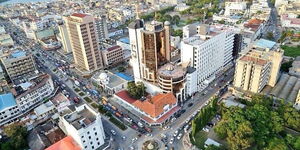Garlic farming is a smart venture earning a few Kenyans who fall in the early adopters' category millions.
From a few success stories for those who ventured into it early, the proceeds of this crop mostly known as 'Kitunguu Saumu' are very high. Garlic belongs to the onion family and is a high-worth horticultural plant owing to its high demand not only in Kenya but across the world. It is usually used in the preparation of special cuisines in different cultures around the globe. It is characterised by a pungent smell.
Garlic is known for preventing colds and flu, aids in reducing the size of a tumor as well as slowing down their growth, aids the body in fighting various bacterial, fungal, and viral infections, and further boosts immunity.
Award-Winning artist Gilad Milo, is among the few Kenyans who are pursuing this new money-making business idea.
He co-owns a garlic farm in a tripartite partnership. They have named it Ole Raha farm and is located off Kiserian road in Isinya, Kajiado County. He has been running the farm for one and half years and is already smiling all the way to the bank.
He converted his earlier farming experience, where he worked with top Israeli firms named Mashav, and later with Amiranto to launch the multi-million venture in Kenya.
Another success story is from a Nyeri-based farmer. Moses Karimi Githaiga has been farming garlic for about six years now. In one of his interviews with a local publication, he revealed that he made sales of Ksh4.8 million in just one farming season.
“I started farming garlic in 2012 on a quarter acre farm. I planted 25 kilos of the onions and harvested 800 kilos.
“I sold the produce at Ksh100 a kilo, earning Ksh80,000 that season,” Githaiga stated, who now cultivates the crop on a 10-acre piece of land.
After a successful experiment in 2012, he increased his acreage to one acre in 2013, where he harvested 4,800 kilos of garlic.
“Last season I earned Ksh4.8 million from 13 acres. But now I vary my planting to supply my customers all year round,” Githaiga stated during the interview.
Prior to that, he only used to be a hawker in Nyalenda and Manyatta slums in Kisumu.
However, most people are probably asking themselves how garlic farming is done and what are the risks involved before it gets running. Just like any other business idea, it has its down sides.
Market Value of Garlic
The demand for this money-making crop usually peaks in the months between May all the way to September. During this period, a kilo goes for a range between Ksh300 and Ksh400.
Their demand decreases only during the festive seasons around December to January. At this period, garlic is sold at around Ksh150 to Ksh200 a kilo. Their prices have never declined below Ksh150. Under well-planned and executed agricultural practices, an acre of garlic produces between 4000 kg to 5000 kg.
But one unfortunate thing is that despite Kenya having good weather that supports garlic farming, approximately 80 percent of the crop found in the market is from China and India. This explains why it is a good business idea for anyone to venture into. Additionally, one does not need to own a farm in order to do it. Renting is also an option.
Growing Garlic
To avoid disappointments in garlic farming, the first step one is required to undertake, is to acquire relevant knowledge about the crop. Not just roadside opinions, but well-thought facts and details regarding the farming process and procedures.
After getting informed, the process of selecting seeds is vital. Farmers are always recommended to get certified seeds free from diseases. Such can only be bought from approved companies.
In Kenya, only three seed varieties do well; softneck, hardneck, and elephant types of garlic.
After choosing seeds, climate conditions is another factor that cannot be ignored. Garlic farming in Kenya thrives in medium to high altitudes of 500- 2000 Metres above sea level. It requires a temperature of above 30 degrees celsius that is essential for bulb development. In the preliminary stages, a temperature of between 12-24 degrees celcius is advised.
Farmers who have established themselves in the industry prefer using controlled greenhouses. High rainfall and humidity is bad for garlic farming.
Soil is yet another important factor to be considered before planting. It requires soil pH ranging from 5.5 to 6.8, this makes it possible to survive in different areas in the country. Only clay is not advisable.
In the planting process, a farmer is required to dig trenches that are 25 cm deep and a spacing of 30 cm between the rows and 15 cm or 6 inches from each plant. After placing the seeds in the soil, little water should be sprinkled. Remember, too much water destroys garlic.
After planting, mulching is advised to protect them from extreme weather conditions. The mulch is removed when the seeds start sprouting.
After that, fertilizer is applied for between 30 and 40 days. The best fertilizer is 5-5-5 or 10-10-10 which specify the amount of Nitrogen, Phosphate, and Potassium respectively in the fertilizer. This should be applied according to the manufacturer's instructions.
Disease control and weeding follow afterward. Garlic is then taken care of, just like a small baby for close to 4 months. The heads usually pop up on the ground indicating they are ready for harvesting.
After harvesting they are dried and stored. At that stage, a farmer can start earning after all the hard work and sweat.












